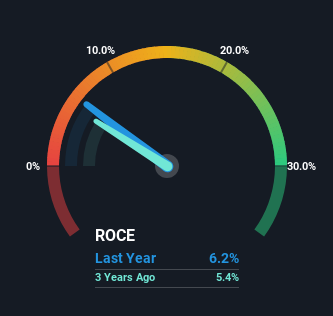- United States
- /
- Machinery
- /
- NYSE:B
Barnes Group's (NYSE:B) Returns On Capital Tell Us There Is Reason To Feel Uneasy

When it comes to investing, there are some useful financial metrics that can warn us when a business is potentially in trouble. When we see a declining return on capital employed (ROCE) in conjunction with a declining base of capital employed, that's often how a mature business shows signs of aging. Ultimately this means that the company is earning less per dollar invested and on top of that, it's shrinking its base of capital employed. In light of that, from a first glance at Barnes Group (NYSE:B), we've spotted some signs that it could be struggling, so let's investigate.
What Is Return On Capital Employed (ROCE)?
For those who don't know, ROCE is a measure of a company's yearly pre-tax profit (its return), relative to the capital employed in the business. Analysts use this formula to calculate it for Barnes Group:
Return on Capital Employed = Earnings Before Interest and Tax (EBIT) ÷ (Total Assets - Current Liabilities)
0.062 = US$181m ÷ (US$3.3b - US$379m) (Based on the trailing twelve months to March 2024).
Therefore, Barnes Group has an ROCE of 6.2%. Ultimately, that's a low return and it under-performs the Machinery industry average of 13%.
Check out our latest analysis for Barnes Group

Above you can see how the current ROCE for Barnes Group compares to its prior returns on capital, but there's only so much you can tell from the past. If you're interested, you can view the analysts predictions in our free analyst report for Barnes Group .
What The Trend Of ROCE Can Tell Us
In terms of Barnes Group's historical ROCE movements, the trend doesn't inspire confidence. About five years ago, returns on capital were 9.5%, however they're now substantially lower than that as we saw above. On top of that, it's worth noting that the amount of capital employed within the business has remained relatively steady. Companies that exhibit these attributes tend to not be shrinking, but they can be mature and facing pressure on their margins from competition. So because these trends aren't typically conducive to creating a multi-bagger, we wouldn't hold our breath on Barnes Group becoming one if things continue as they have.
What We Can Learn From Barnes Group's ROCE
In summary, it's unfortunate that Barnes Group is generating lower returns from the same amount of capital. Investors haven't taken kindly to these developments, since the stock has declined 14% from where it was five years ago. Unless there is a shift to a more positive trajectory in these metrics, we would look elsewhere.
On a final note, we found 4 warning signs for Barnes Group (2 are potentially serious) you should be aware of.
For those who like to invest in solid companies, check out this free list of companies with solid balance sheets and high returns on equity.
Valuation is complex, but we're here to simplify it.
Discover if Barnes Group might be undervalued or overvalued with our detailed analysis, featuring fair value estimates, potential risks, dividends, insider trades, and its financial condition.
Access Free AnalysisHave feedback on this article? Concerned about the content? Get in touch with us directly. Alternatively, email editorial-team (at) simplywallst.com.
This article by Simply Wall St is general in nature. We provide commentary based on historical data and analyst forecasts only using an unbiased methodology and our articles are not intended to be financial advice. It does not constitute a recommendation to buy or sell any stock, and does not take account of your objectives, or your financial situation. We aim to bring you long-term focused analysis driven by fundamental data. Note that our analysis may not factor in the latest price-sensitive company announcements or qualitative material. Simply Wall St has no position in any stocks mentioned.
Have feedback on this article? Concerned about the content? Get in touch with us directly. Alternatively, email editorial-team@simplywallst.com
About NYSE:B
Barnes Group
Provides engineered products, industrial technologies, and solutions in the United States and internationally.
Fair value with moderate growth potential.
Similar Companies
Market Insights
Community Narratives



